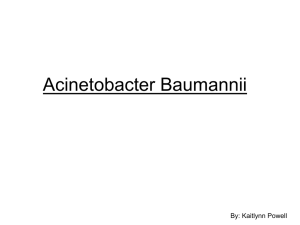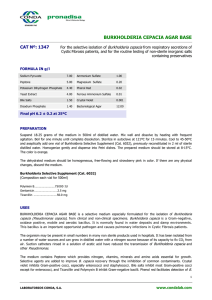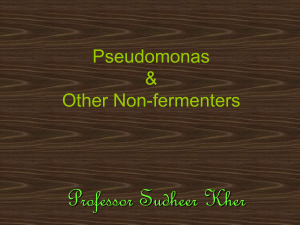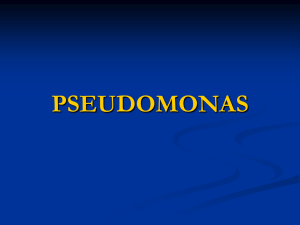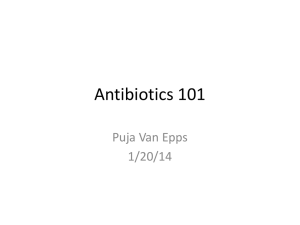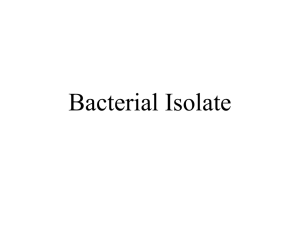Acinetobacter
advertisement
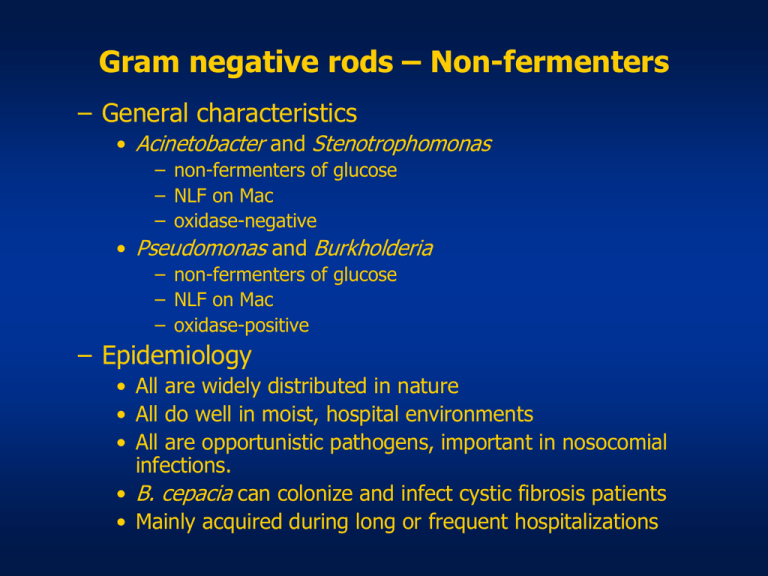
Gram negative rods – Non-fermenters – General characteristics • Acinetobacter and Stenotrophomonas – non-fermenters of glucose – NLF on Mac – oxidase-negative • Pseudomonas and Burkholderia – non-fermenters of glucose – NLF on Mac – oxidase-positive – Epidemiology • All are widely distributed in nature • All do well in moist, hospital environments • All are opportunistic pathogens, important in nosocomial infections. • B. cepacia can colonize and infect cystic fibrosis patients • Mainly acquired during long or frequent hospitalizations – Pathogenesis • Acinetobacter and Stenotrophomonas – virulence factors unknown – intrinsic and acquired multi-drug resistance – respiratory tract, soft tissue/wound infections, bacteremia • Burkholderia – largely unknown, ? binding to resp. mucin in CF patients – intrinsic resistance to antibiotics – respiratory tract, soft tissue/wound infections, bacteremia • Pseudomonas – exotoxins, proteolytic enzymes, alginate – acquired multi-drug resistance to antibiotics – respiratory tract, soft tissue/wound infections, bacteremia – Laboratory Diagnosis • Specimen collection, transport, and processing – no special considerations • Direct detection methods – – – – Acinetobacter: plump coccobacillary GNR Stenotrophomonas: short, straight GNR Burkholderia: med., straight GNR Pseudomonas: med., straight GNR • Culture – All grow well on BAP, CAP, Mac – PC/BC agar for Burkholderia » selective media for B. cepacia; color of colonies varies with media formulation • Testing on automated systems – ID and sens testing of NFs on automated systems can be problematic – Isolates from CF patients are always tested manually Acinetobacter on Gram stain http://www.rivm.nl/infectieziektenbulletin/bul122/scan12.gif Stenotrophomonas on Gram stain http://www.buddycom.com/bacteria/gnr/xanmalt2_5.jpg Pseudomonas on Gram stain http://www.bact.wisc.edu/Bact330/P.aeruginosa.jpeg Pseudomonas on solid media http://www.silvermedicine.org/colloidalsilverstudytexas.html Burkholderia on PC Agar http://www.troybio.com/images/Product_Images_BBL/BBL.htm – Laboratory Diagnosis • Colony appearance – Acinetobacter: gray, smaller than enterics; may look purple on Mac – Stenotrophomonas: Larger than Acinetobacter; smells like ammonia – Pseudomonas: green, flat, spready, hemolytic; smells like grapes » mucoid in CF patients » pyocyanin: green pigment – Burkholderia: smooth gray • Identification: – Acinetobacter and Stenotrophomonas: oxidase neg., nonenteric looking gnr on gram stain; ID by API non-ferm; Acinetobacter ID on VITEK2 – Pseudomonas: colony morph; Gram stain; oxidase pos; growth at 42C; pigment production; glucose oxidizer – Burkholderia: screening resp. specimens from CF patients only; all cultures get PC agar – Susceptibility testing and therapy • Acinetobacter: – – – – test if clinically significant resistance among classes, so results guide therapy KB and MIC various treatment options • Stenotrophomonas: – – – – test if clinically significant multiply resistant so Rx can be limited in vitro results to beta-lactam drugs are unreliable Trim/Sulf is primary treatment option • Pseudomonas: – susceptibility results guide therapy – can be highly resistant – usually treat with anti-Pseud beta lactam + an aminoglycoside because resistance develops quickly • Burkholderia: – No valid testing methods or interpretive guidelines – treat empirically with pip, ceftaz, imipenem but organism is rarely eradicated
